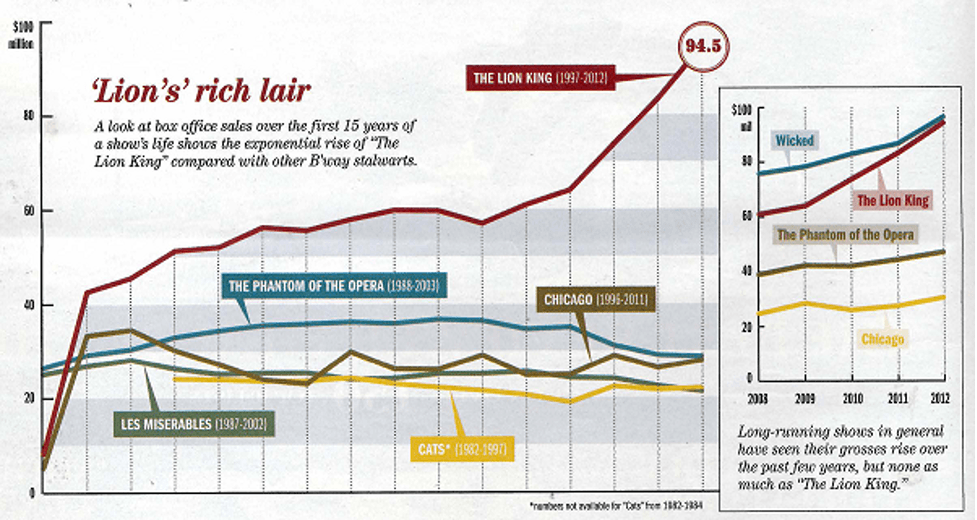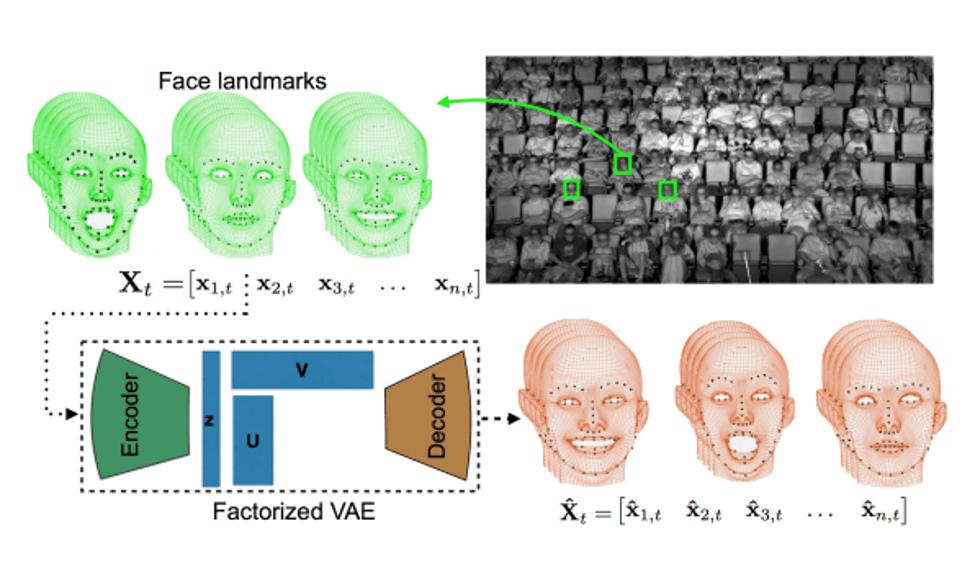Disney Magic with Big Data

“Technology is lifting the limits of creativity and transforming the possibilities for entertainment and leisure.” – Bob Iger, Chairman and CEO, The Walt Disney Company
Disney is one of the brands well known in every part of the world. Mickey Mouse, the most valuable character along with many others that appeared in a hundred years of history, is delighting customers and consistently enabling the brand power of entertainment company to grow. Has it been ever associated with data or consumer business analytics? I wouldn’t say so, however, a team of over 120 data analysts is doing a great job across many lines of businesses for more than two decades.
Broadway analytics
It has been now a classic example demonstrating the success of data analytics applications to manage entertainment events and businesses. The first area where business data analytics was impactful is a revenue management system. It has been applied to manage dynamic pricing of “The Lion King” show at Broadway, which eventually has generated more revenue than any other Broadway show ever. As can be seen from the comparison of revenues in the first 15 years, many of the show in general experience growth but only “The Lion King” grew exponentially. There were many factors that contributed to the rise of a show: 1) first of all, the show is actually great, along with 2) the perfect location of the event, 3) growing rates of tourism hitting record number and 4) marketing right in the middle of Times Square that tourists can not miss when they do their stop. However, the setting prices strategy was similar to other shows or even the average price was never higher than shows, so what made it possible? The dynamic pricing approach and tools which were built in a similar way to other industries such as airlines and hotels activated many other factors that made it possible.
The weekly Variety has defined two main factors: “First, the range of prices across the theater is set according to an estimate of the demand for a particular performance, based on the 15 years of past (box office) from which to extrapolate annual trends. Second, after tickets go on sale, Disney re-examines each (performance) to see how demand is shaping up in reality, and then tweaks pricing accordingly.” It means tailoring and personalization in pricing consider factors such as box office reactions, customer feedbacks, weather, the number of people in queues and specific times of the day, and so on.
Disney World analytics
Let’s have a look at other business lines of Disney. The corporation integrated data analytics in the theme parks of Disney World to make more customized and superior entertainment possible. It all started from implementing MagicBand wearable wristbands which allowed a friction-free visit of parks along with collecting valuable data about customers’ experience. The band serves multiple purposes starting from the Fastpass+ reservation tool which customizes experience before visiting the park and serving as a parking tool, a room key, a payment card. The reservation tools allow customers to avoid lineups and provide personalized routes in the park. On the Disney side, it allows gathering behavioral patterns through data which allows defining where customers spend the majority of time. Geo-targeting is another function that allows delivering services knowing the current location of customers. The algorithm predicts where and when the family will sit for dinner so the kitchen staff can start on the food the family ordered earlier. Since it was invented in 2013, the MagicBand allowed accommodating 3,000 more visitors per day, whereas on Disney’s side machine learning can better allocate 80,000 employees across 240,000 shifts each week.
Disney movies analytics
Another application of data analytics emerging recently is measuring the reactions of viewers while watching movies either in Disney+ streaming service or in movie theaters. Since it was launched in 2019, Disney+ has 50 million paid subscribers enjoying Disney, Marvel, Pixar, Star Wars, and National Geographic universes. It is not something radically new as it replicates analytics measuring consumer behavioral data introduced on competitive streaming services such as Netflix away before Disney+.
Disney Research is having developed and now experimenting with a neural network that has been trained to watch an audience in movie theaters. It is capturing the facial emotions and reactions of viewers such as smiling or laughter at an extremely more granular scale. After it was tested in 150 shows, it has generated 16 million data points measuring reactions of 3,179 people. Further on it will allow content providers to dynamically reshape and adjust content to our liking. Imagine if it is brought to Disney parks to measure interactions of visitors with movie characters or even with vending machines or in food restaurants.
Conclusion
With all these data captured after your first experience with Disney World, the sales and marketing teams will be able to prepare and send personalized offerings for your next visits. Comparing to relatively small investments ($1 bln.), would they be able to continue generating revenue with all data being captured. Would people be willing to share data at scaring level of granularity? How the company is going to recover from the pandemic when all parks were closed?
References
“Broadway ‘Lion King’ Roars Louder – Variety”. 2021. Variety.Com. https://variety.com/2013/legit/news/broadway-lion-king-roars-louder-1118065538/.
“Disney Transforming Theme Park Experience With Tech And Iot | Blooloop”. 2021. Blooloop. https://blooloop.com/theme-park/news/disney-internet-things-wearable-technology/.
“Disney’S Next Movie Could Be Watching You, Too”. 2021. Fast Company. https://www.fastcompany.com/90134144/disneys-next-movie-it-could-be-watching-you.
“How Disney World Uses Big Data”. 2021. Medium. https://randerson112358.medium.com/how-disney-world-uses-big-data-24de9c1175a5.
Rangaiah, Mallika. 2021. “How Disney Uses Behavioral Analytics For Customer Experience? | Analytics Steps”. Analyticssteps.Com. https://www.analyticssteps.com/blogs/how-disney-uses-behavioral-analytics-customer-experience.
School, Columbia. 2021. “Why “The Lion King” Roars So Loud: Business Analytics At Disney”. Business Analytics. https://www8.gsb.columbia.edu/bizanalytics/content/why-%E2%80%9C-lion-king%E2%80%9D-roars-so-loud-business-analytics-disney.





The point you raise about how Disney responds to Covid is particularly interesting. Re-engineering (re-imagineering?) the Magic Bands and the data from them could in particular help the recovery of its theme parks. While the Magic Bands so far have been useful in improving resource utilization, you could see a world where the same bands were used in real-time to enforce caps on headcount or enable contact tracing with higher levels of precision and risk analysis (e.g., length of interaction).
On your last point on data movie analytics, I found Disney Research’s analysis of audiences’ reactions at the movie theater both fascinating and frightening. While data can provide valuable insights into elements in the movie that the audience liked or didn’t like thus improving quality of its content, I’m concerned about the privacy implication of allowing these systems to penetrate these space. Is privacy something Disney is evaluating as they explore these technologies?
Almas, this line was absolutely shocking to me: “It is capturing the facial emotions and reactions of viewers such as smiling or laughter at an extremely more granular scale. After it was tested in 150 shows, it has generated 16 million data points measuring reactions of 3,179 people.”
This reminded me of our discussion in class about how TV broadcasts could rely on one single metric, essentially, to understand viewer engagement: Nielson Ratings. Does Disney sell this data?
Intrusive data gathering is becoming a big problem in the streaming space. In 2018, two Democratic senators asked federal regulators to investigate the business practices of smart-television manufacturers amid worries that companies are tracking consumers’ viewing behavior without their knowledge… In fact, one study uncovered that Roku, Amazon Fire TV, and other companies have expanded the surveillance infrastructure that operates in the background of streaming services…Research suggests that even when viewers try to shield their information, it is sometimes tracked without their permission and shared with tech giants like Facebook, Google and Netflix. This will certainly be a growing problem moving forward in this space….
Really fascinating piece. Thank you for the great read Almas!!
Regarding the MagicBand use case – Disney has also done interesting things in regard to payments and what wearables can usher in from an experiential perspective. Customer purchasing data, geotargeting and security in this closed loop system do give me concern around surveillance and privacy. The more usage puts Disney in a unique position that they themselves or bad actors can subvert and exploit.
Great post Almas!
This is very interesting and somewhat scary at the same time.
Disney is combining the pricing analytics of an airline company with the data generated by an Apple Watch (incl. Google’s Waze super feature) and the customer insights of Netflix…
If you ask me, the question is not how Disney will handle the post-Covid era but how far their moonshot will go!
Love this viewpoint of Disney Almas. It is especially relevant because pre Disney+, not too many consumers would have looked at Disney as a company particularly interested in collecting data or manipulating it. It was just not a part of their image.
But seeing this blog, one gets to take a deeper look at a company most of us grew up with and understand the relevance of data in why they are successful. The entertainment industry has always been an early adopter of new technologies and Disney just goes to reinforce that point.
Some of the things you mentioned about analyzing facial reaction are terrifying because employees at the company would definitely have ways to gain access to these images/videos which is a huge threat to their clients privacy.
Excellent post, Almas! Do you think Disney’s technology has not kept up with the times? With the COVID-19 pandemic shaking up the movie theater industry, much of the entertainment today is delivered through direct streaming. I doubt anyone will be watching Disney+ with their cameras on if they know that Disney is tracking them. Do you think these analytics of movie theater attendees will prove to be a worthwhile over investment into streaming user behavior on Disney+, the area where Netflix has found so much success?
Vartan, thank you for your comment. Have just checked the latest news. It has been announced Disney is going to test facial recognition in theme parks in Orlando starting from April. The primary objective, as was announced, it to make experience of visitors as much contactless as possible.
Thanks for the post Almas! Lots to be amazed, and some to be a bit scared by such as the facial recognition analytics. On the magic band, I wonder if this will become a status quo move for the industry. It is a bit invasive, but as long as it is within Disney’s domain it is fair game and a genius move to capture data from its captive audience. I see no point in competitors not copying Disney, but at the same time wonder if there are any significant patent barriers built up by Disney.